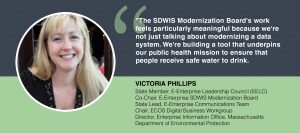
What are your current efforts on behalf of the E-Enterprise initiative?
At the moment, my main E-Enterprise focus is to optimize the modernization of the Safe Drinking Water Information System (SDWIS). I’m delighted to serve as Co-Chair of the SDWIS Modernization Board along with my fellow EELC member Benita Best-Wong of the EPA Office of Water. As Board members, we’re helping to ensure that the new system meets the needs of as many agencies as possible in a way that is efficient and sustainable over the long term. Drinking water programs play such an important role in protecting public health, and they all run on data. So, the Board’s work feels particularly meaningful because we’re not just talking about modernizing a data system. We’re building a tool that underpins our public health mission to ensure that people receive safe water to drink.
I’ve also had the pleasure of leading state participation in the E-Enterprise Communications Team, whose job is to spread the word far and wide about the activities and successes of the overall E-Enterprise initiative. Our team strategizes on messaging, managing an E-Enterprise website and producing useful content like this intro video and fact sheets on the many projects in the E-Enterprise portfolio. We also coordinate regular outreach at meetings of state associations and tribal groups, maintain a Twitter feed, and publish the quarterly Bulletin that you’re now reading.
What have been the most rewarding aspects of your involvement in E-Enterprise?
It’s been rewarding to collaborate with other states in our journeys toward information modernization. . In one E-Enterprise permitting webinar, for example, I shared how the Massachusetts Department of Environmental Protection (MassDEP) worked with other state agency partners to streamline processes, after which we developed and deployed a scalable e-permitting platform using standard components and workflows for MassDEP and the Massachusetts Departments of Agricultural Resources and Conservation & Recreation. This was a big undertaking through which MassDEP developed eight standard workflows encompassing 258 permit types and 15 data standards. I heard from many participants after the webinar, and learning about their own experiences helped me to continue to make improvements in our e-permitting effort.
You’ll also find my name on the user leaderboard of the E-Enterprise Community Inventory Platform (EECIP), which is one more valuable avenue for “show and tell” among the E-Enterprise partners and other state, local, and tribal environmental agencies across the country. Through this online community and living project inventory for IT, process improvement, advanced monitoring, and other matters, I’ve been able to connect many dots. For instance, an EECIP thread I initiated on Regulated Entity Portals generated countless good ideas that I’ve been able to bring back to my home agency.
In another success story, I was honored to partner with former EELC Tribal Co-Chair Micco Emarthla (who sadly has since passed away). Micco spearheaded efforts to improve the timeliness of EPA Quality Assurance Project Plan (QAPP) review and approvals. Our effort began with a process improvement event and development of metrics and tracking, and ultimately led to improved performance and increased communication as a result of this effective state, tribal, and EPA collaboration. You can read more about the QAPP project’s achievements on the E-Enterprise website.
Are you involved in any other projects that align with and support the principles of E-Enterprise? How will that work improve environmental outcomes?
Yes! In work aligned with that of E-Enterprise, I chair the ECOS Digital Business Workgroup (DBWG) alongside Vice Chair Neil Chakrabarty of West Virginia. The DBWG brings together state agency staff working at the intersection of environmental protection and IT policy. Over the past year, we’ve had opportunities to talk about cross-cutting issues that agencies face, including challenges to essential agency functions. From cybersecurity to managing changing workplace environments related to the pandemic, the DBWG allows states to share a wealth of perspectives and experiences with our counterparts across the country.
The ways in which states employ technology to support information management is ever-changing and central to states’ ability to carry out our environmental missions. To me, a venue like the DBWG is essential to our work in E-Enterprise – to host conversations that spur ideas and share how our state colleagues are modernizing the business of environmental protection.
